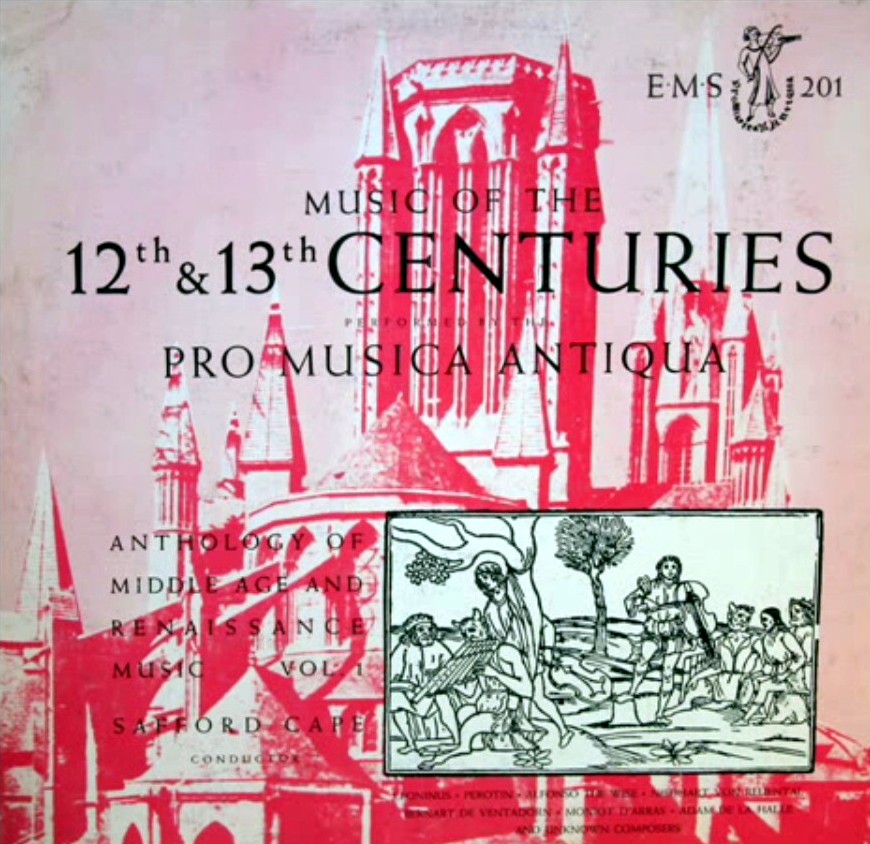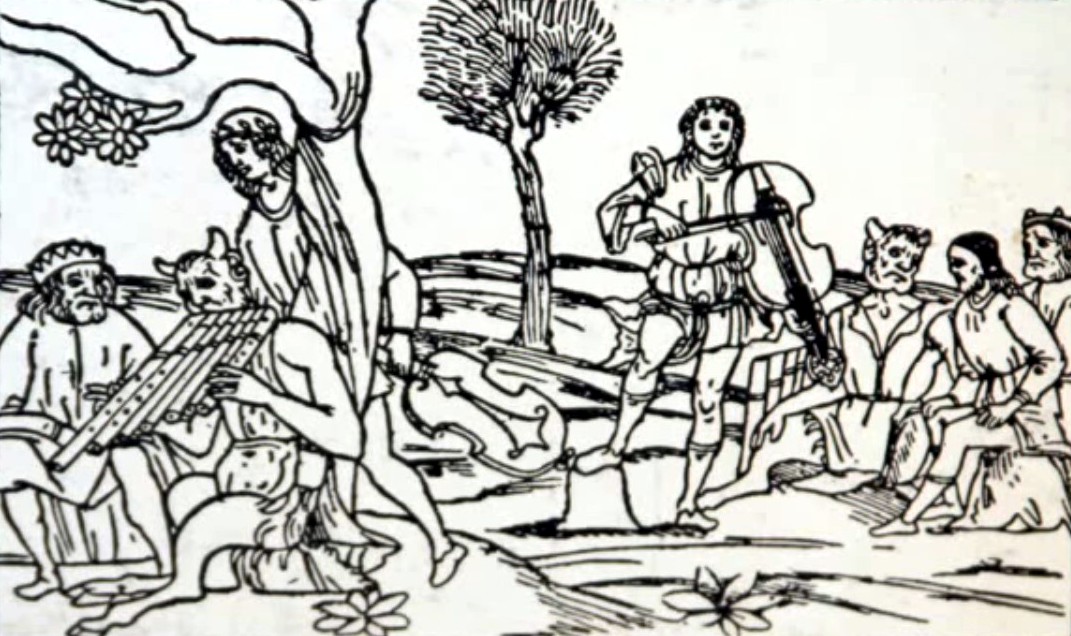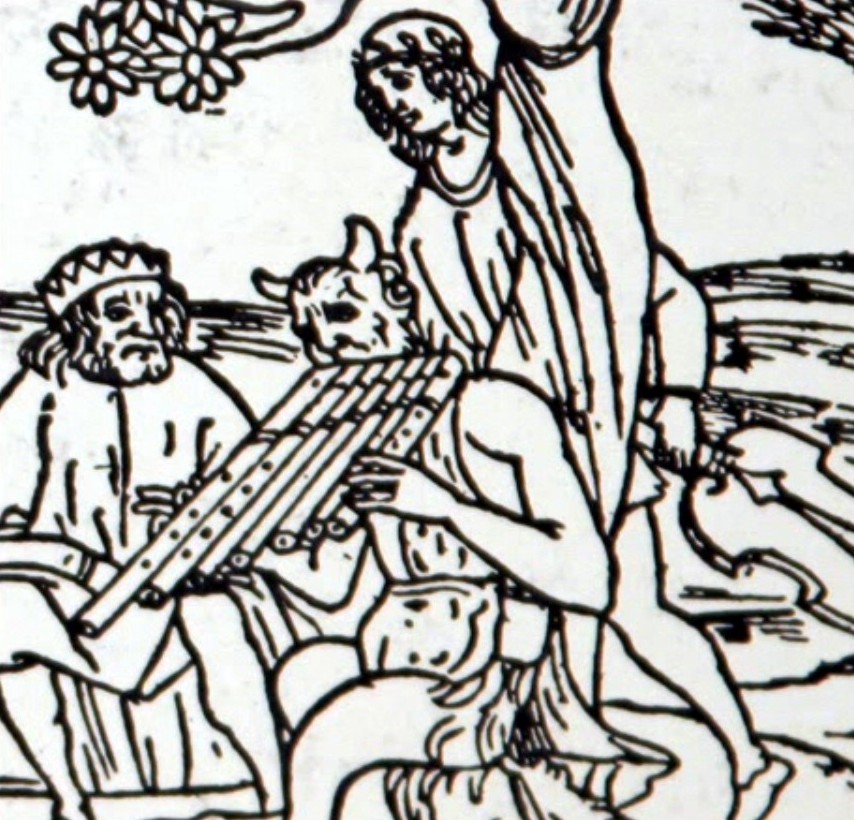Music of the 12th & 13th Centuries
Pro Musica Antiqua, Brussels, Safford Cape

medieval.org
discogs.com
Elaine Music Shops EMS 201 (LP, mono)
1951
Side One—Sacred Music
1. In saeculum artifex [1:29] sacred motet,
Codex Las Huelgas
Hu 119
treble viol, tenor recorder, lute
2. Deum time [4:08] organum duplum —
LEONINUS
vocal ensemble – soloist: Franz MERTENS
3. Alleluia psallat haec familia [1:05] Worcester Fragments
treble recorder, treble viol, lute
4. Beneyto foi [2:10]
ALFONSO THE WISE
CSM 411
barytone, treble viol, treble recoder, lute –
soloist: Albert VAN ACKERE
5. Benedicamus Domino [2:17] organum duplum,
Codex Las Huelgas
Hu 37
vocal ensemble – soloist: Franz MERTENS
6. Deus misertus [1:57] conductus — attributed to
PEROTIN
treble recorder, treble viol, lute, tenor viol
7. Ave verum corpus [1:56] trope,
Codex Las Huelgas
Hu 19
two tenors
8. A la clarté [1:21] minstrel's hymn,
Montpellier | Wolfenbüttel (W2)
tenor, tenor viol – soloist: Franz MERTENS
9. Virgo [2:14] organum triplum —
PEROTIN
vocal ensemble
Side Two—Secular Music
1. La quinte estampie réal
2. Bele doette
3. En Mai la rousée
4. Mayenzeit — NEIDHART von REUENTHAL
5. Can vei la lauzeta — BERNART de VENTADORN
6. Ce fut en mai — MONIOT d'ARRAS
7. In saeculum viellatoris — Codex Montpellier | Codex Wolfenbüttel (W2)
8. Entre copin et bourgois — Codex Montpellier | Codex Bamberg | Torino MS Vari 42
9. Amours et ma dame aussi — ADAM de la HALLE
10. Li dous regars — ADAM de la HALLE
11. Stantipes

PRO MUSICA ANTIQUA of Brussels
Safford Cape
Franz Mertens — tenor
Albert Van Ackere — baritone
Jeanne Deroubaix — contralto
Suzanne Bouquette — voice
Maria Ceuppens — soprano
instruments:
tenor viol, treble viol, tenor recorder, descant recorder, treble recorder, lute, drum, minstrel's harp
recording: Brussels, autumn 1950
Notes and translations by Safford Cape
:format(jpeg):mode_rgb():quality(90)/discogs-images/R-4122660-1356031539-5139.jpeg.jpg)
The
music of the twelfth and thirteenth centuries is an aspect of the first
great flowering of Western civilisation, and is part of the creative
outburst which gave virth ti the Romanesque and Gothic Cathedrals, the
narrative, satiric or poetic masterworks of mediaeval literature, the
philosophy of St, Thomas Aquinas and St. Bonaventure, and, in the field
of social development, the passage from serfdom to the modern conception
of freedom, inspired and led by men like St. Francis of Assisi and St.
Dominic. Like the others arts, music found the forms best adapted to the
active role it eas called upon to play in mediaeval life, and reached a
richness and diversity of perfection equal, if not superior, to that of
preceding centuries.
The Church had the privilege of fathering,
from about the eleventh to the end of the thirteen century, the first
great polyphonic form created by our civilization, the Organum, so
called probably because it represents combined and "organized"
part-music. From the Organum were derived the Motet and the Conductus,
the two latter forms being either sacred or secular. Paris was the great
center form which polyphony spread over Europe and to the British
Isles, although the latter has a method of their own, in which thirds (a
dissonant interval at the time on the Continent) were used to a large
extent.
Music consisting of nothing but a melody, without harmony
or counterpoint (called monody), played a role of prime importance
in the twelfth and thirteenth centuries, as it probably has since the
beginnings of humanity (whereas what we call polyphony is a creation
of our Western civilization). In Southern France, influenced by the song
of the Church and perhaps by the Arabs, art-song composers, most of
whom were nobles, appear at the end of the eleventh century. They are
called Troubadours, from a Provençal word primarily meaning "maker of
tropes" (a kind of liturgical poetry). The influence of these composers
was first felt in Spain, Portugal and Italy, and extended, in the
twelfth and thirteen centuries to Northern France, where such composers
were designated by the same name as in the South, which in Northern
French was Trouvère. The movement spread to Germany, and many
Minnesanger (Singers of love) as the German song-composers were called,
left beautiful works. As to England, it would seem that she depended
principally on French Troubadours and Trouvères for her monody.
Besides
the intricate polyphonic forms and the highly refined monodic ones, a
third world of music was governed by the Minstrels, or popular musicians
and composers. These gave especial attention to dances. Their works,
not so highly prized as those of their learned brethren, were generally
not written down. Fortunately, however, those that were are sufficient
to give us an excellent idea of minstrel music.
Biographical Details
LEONINUS, PEROTINUS. Of these, the two great masters of
Organum, absolutely nothing is known, excepting that they were
connected with the metropolitan church Notre Dome de Paris, that
Leoninus preceded Perotinus, who died some time between 1200 and 1240.
ALFONSO X, the Wise, King of Castile, and Leon (d. 1284). A great student and patron of literature, music and science.
BERNART de VENTADORN
(1130-1195), a troubadour, was the son of o servant at the castle of
Ventadorn, in the French province of Limousin. It is said that he become
enamoured of the young Viscountess of Ventador, and so was banished by
the Vicomte. He entered into the service of Eleanor of Aquitaine, later
wife of Henry II of England, and visited the English Court.
MONIOT d'ARRAS
(13th century). Belonged to the circle of minstrels of Arras, in
Northern France. Arras was the seat of o famous confraternity, the
"Charity of the Ardents," which commemorated the miracle of the Holy
Candle -- about 1100, the city had been delivered from the pest ("mal
des ardents") by the Virgin Mary, who appeared to two minstrels. At the
end of the century, 182 minstrels belonged to the confraternity, which
did much to put its members in a privileged position.
ADAM de la HALLE
(d. 1287-88). Born in Arras. After having gone through the usual
studies to become a "clerc" lettered man), he fell in love with Moroie,
and married her. Shortly after, he completed his studios in Paris, and
returned to Arras where he lived as a minstrel until a fraudiulous
fiscal undertaking, in which he was compromised, obliged him to leave
Arras for Douai. The storm over, he was engaged by the nephew of the
King of France St Louis, Robert II of Artois, whom he eventually
accompanied to Italy. He died at the age of 47.
NEIDHART von REUENTAL
(beginning of the 13th century) a Minnesinger Bavarian by birth, he
lived in Austria. He took part in the Crusades, and was present at the
siege of Damietta in 1211.



:format(jpeg):mode_rgb():quality(90)/discogs-images/R-4122660-1356031539-5139.jpeg.jpg)
